by Cristina Ramos // Aug. 22, 2023
This article is part of our feature topic Wilderness.
Alice Morey is an artist who works with painting, sculpture and textile to build delicate installations. Within the often chaotic space of wilderness, as a concept, she brings to the fore the haptic qualities of things—their smell, their taste, their touch. In order to re-make signifiers around certain problematic categories—such as the feminine or the end of life—Morey creates a cosmology where substances stand by themselves and affect us, as though we are just one small element among many in the environment. In recent years, she has developed a performative practice that encompasses installations and rituals, often carried out in collaboration with non-human elements and with her audience.
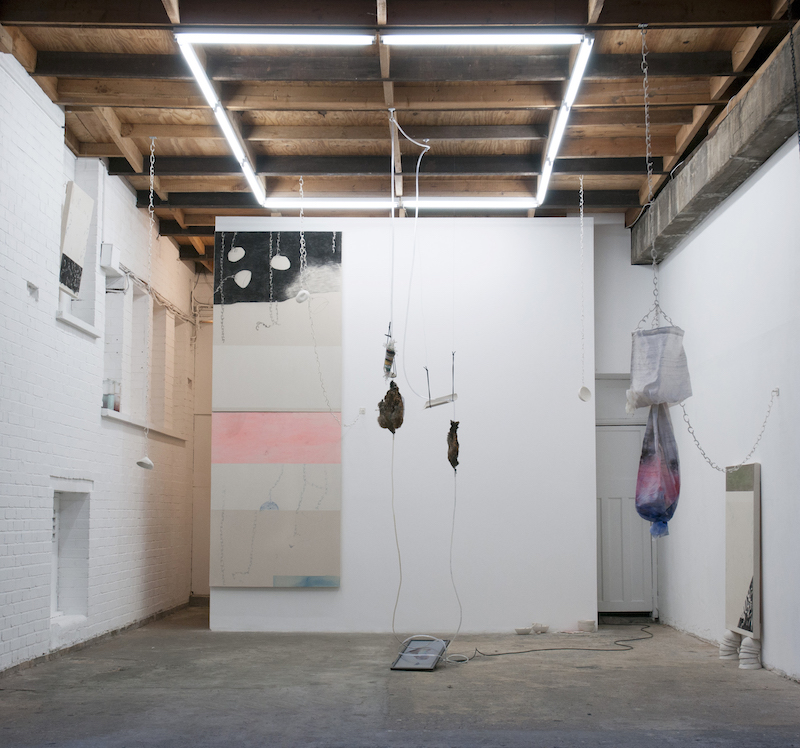
Alice Morey: ‘She doesn’t love, she just devours,’ 2019, the Ryder // Photo by Aina Pomar
Cristina Ramos: Wilderness is a cultural concept that serves as a projection for categories like “the other” and “the alien,” for fantasies of desire beyond the boundaries of a tamed social model. In your show ‘She doesn’t love, she just devours’ at the RYDER Projects in London in 2019, there were many elements (like the pheasants or urine) that belong to a fragile and intimate feminine realm. Where would you place this notion of otherness and how do you deal with it in the work?
Alice Morey: I feel that the “wilderness” element that belongs to this installation resonates deeply within myself. It forms from an internal drive to push forward questions I have around gender, class and expectations as a community. When I talk about community, I mean several groups of people that form bonds, finding common interests that then can relate to a common socio-ethical mind. I like to “perform” these questions to an audience in the form of an experiential installation. This otherness comes from an unknown and uncontrollable force that I believe is in a lot of us, in our feminine side, no matter what gender you may identify with. I think it comes from not being afraid to get in touch with a sensitivity and care element within our minds and bodies: the nurturing side, the safety, taking time to understand an otherness in the spaces we occupy and where we associate ourselves in a physical realm that can transform into a mental, then spiritual realm. It is also about being open to challenging ourselves, looking into natural cycles of being as a physical body: we are a clock and we have our own rhythms in our bodies.
I feel like creating these spaces or rituals through performance plays a big role in trying to deal with my curiosity around nature and the non-human, negotiating our interruption of life, death and the afterlife through energy pulls. In this way, the element of death was very present in this installation and it came forward as a site of ritual in the gallery space, a former garage in east London. Specifically, this was true in connection with the pheasants in this installation, which were either hanging with urine bags in the work ‘Quit playing games with my heart’ or in the performance ‘Pure,’ served to the audience in a homemade pheasant soup, out of porcelain bowls, made in front of them at the opening.
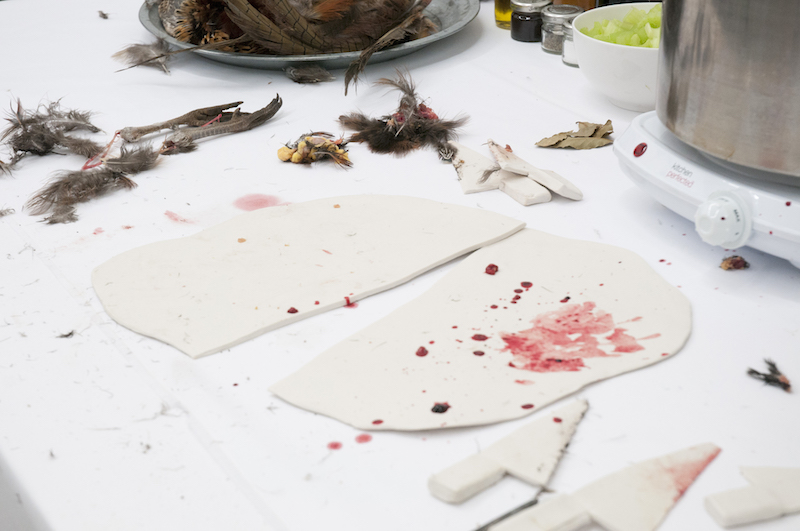
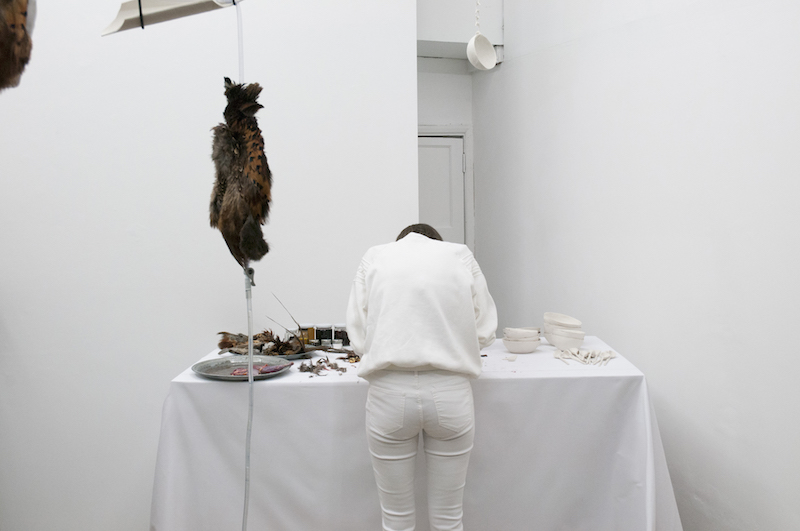
Alice Morey: ‘Pure,’ 2019, performance at the Ryder // Photo by Aina Pomar
CR: I would define your painting practice as highly interconnected and mystical. To integrate us into the complex network of universal energy flows that form the spaces we inhabit, you work with pigments that you make yourself or with bacteria. Are you seeking a physical shaking off of matter and to psychically shake up the audience, rather than to suggest articulated narratives about symbiosis?
AM: I agree that my paintings are powerfully mystical. This comes through in the intuitive mark-making, a visual space for an interwoven calming dialogue within the material process, right through to the physical space. Their mood, their synergy, the elements of sensitive touch and power within physical mark-making, the gesture moving from inner self to hand and out again through a tool, elements of letting go and ceasing control.
I think I am dealing with both of these that you mentioned. On the one hand, I want to disturb the audience by using elements within my painting, like bacterias, that mould and decay over time, trying to discover, in a way, a metaphor of death and rejuvenation. [I am interested in] dealing with the psychological elements of letting go, the loss of control through the emotional body, the disgust and disturbance with the history of painting, conservation and the art market, contradicting the idea that an image lasts forever, but is changing and unpredictable. You can see this, as an example, through the paintings that were in my recent solo exhibition in MEWO Kunsthalle. And, on the other hand, I am using these elements of morphosis to talk about symbiosis, which can be seen in my recent duo exhibition with fellow artist and friend, Dietrich Meyer, where the paintings hold a symbiosis with a more spiritual ground. The marks are transforming from the pigments collected from places I have travelled recently, stones and minerals, to a spatial awareness of the painting. It transforms into a sort of dance with elements.
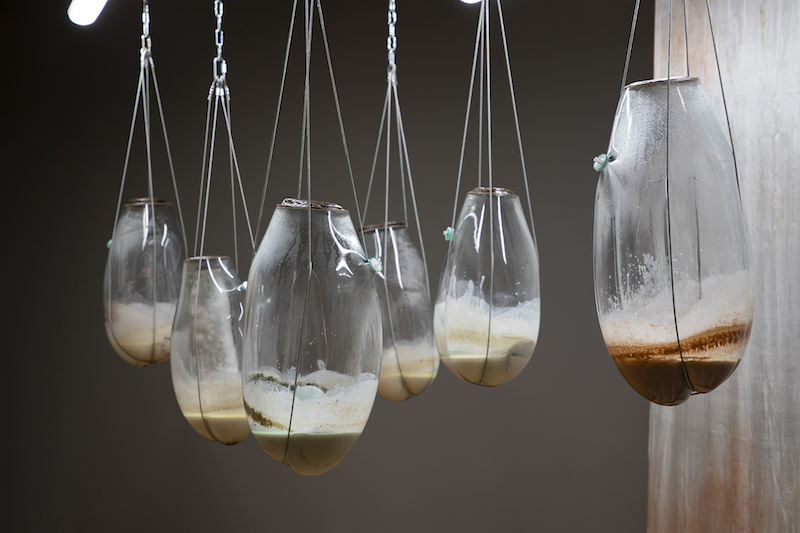
Alice Morey: ‘Conditioning Demands,’ 2022, curated by Lorenzo Graf at MEWO Kunsthalle // Photo by Sebastian Bühler
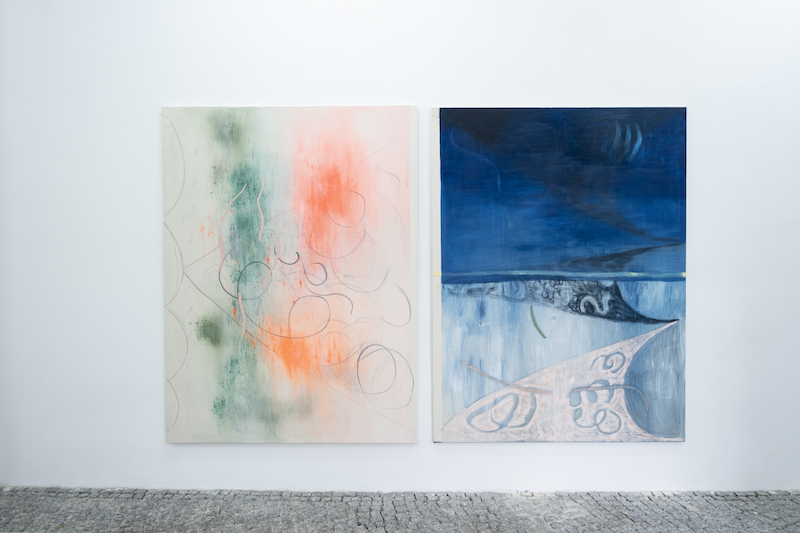
Alice Morey & Dietrich Meyer: ‘The tie that binds,’ installation view at gr_und, Berlin (DE), 2023 // Courtesy of the artist
CR: ‘The Dissolving Palette’ at Cafe Bravo (KW Institute for Contemporary Art) last year was a feast for which you collaborated with edible ingredients, as well as with your guests, to create a haptic experience of eating. Often in your performances, you hold space for things to have their own agency, provoking an increase in our levels of perception. How controlled is this process of transformation, from your side? What’s the role of compulsion over choice in your work?
AM: This element of compulsion is that it’s uncontrollable. It’s about destruction, the unknown and trusting in the idea of the physical interaction with something or someone, which leads to an unexpected collective journey that creates something new. I think this is important in art making. It may be seen as careless, but I think that allowing oneself to get lost or let go of certain inhibitions helps us to understand that we can not change our roles in a “bigger whole.” We are many bodies on the same planet, smaller and more insignificant than we know. Trying to control too much could become frustrating.
I think, in particular, with this performance I wanted to hold a space to apply a few agencies to a group of people to work with. By doing so, it felt like staging the uncontrollable between the audience and the material, placing them as mere actors and agents that led into an improvisation. This improvisation was centred around their inability to use the only tools that were given to them and find a way to essentially eat with these tools, restricting them and guiding them to become playful and find solutions.
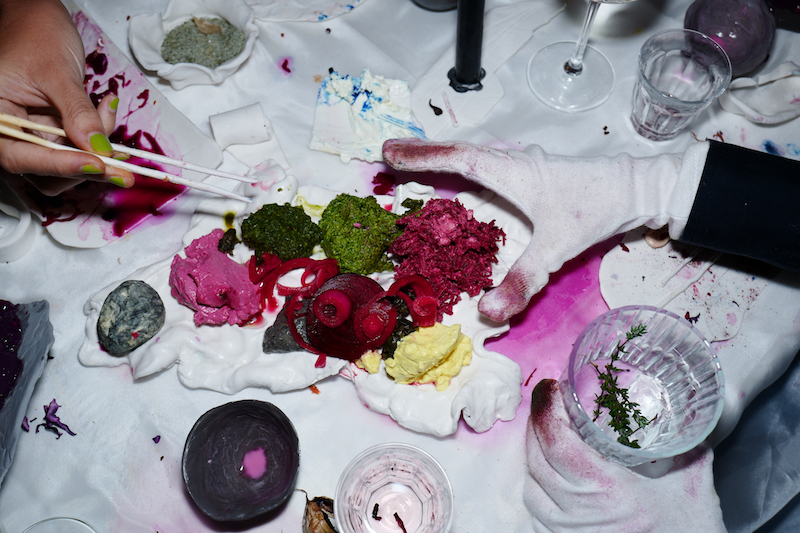
Alice Morey: ‘The Dissolving Pallette,’ 2022, a collaboration with BLANK 100 & Cafe Bravo, food made by the artist and Paula Erstmann // Photo by Lexi Sun
CR: Your paintings seem to be a place for celebrating the untranslatable consciousness beyond the human, whereas in your installations you confront yourself and the audience with other thing-qualities, such as the uncanny. Is this a way of exploring the gaps between experiences? How would you describe the concept of wilderness, in relation to this?
AM: Yes, I think it is definitely a part of it, but also filling in a big curiosity I have myself with wilderness and the relationships to nature, as if I am constantly discovering new possibilities within a spiritual otherness of myself and how that connects me to another non-human, and then to an environment. It’s like some sort of spell forming and being moved in a mark. While the installations and performances are very much about trying to understand, as a group experience, our relationship to each other through confronting difficult topics like death and temperance, the paintings act as a transferred force. They capture a moment of time in an “other” world, which can be unexpected and not explained. It’s actually a very moving and emotional process.



















